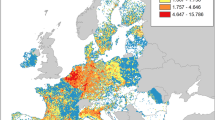Abstract
The exploding increase in trade between the United States and China, which share comparable ecosystem types, will result in unwanted establishment of alien invasive species that will inflict considerable ecological and economic damage. This undesirable result can be avoided by marshaling management tools and policy instruments that are readily available. High-level policy action is necessary to put the proper and available safeguards in place, and quickly.
Similar content being viewed by others
References
Anonymous (2004) Scientists to stop invasive plants. Retrieved from http://news3.xinhuanet.com/english/2004-11/03/content_2171078.htm on Nov. 22, 2004
Campbell F and Schlarbaum S (2002) Fading Forests II: Trading Away America’s Natural Heritage. American Lands Alliance, Washington, DC, 95 pp
China Council for International Cooperation on Environment and Development (2002) Strategies for controlling invasive species in China. Beijing
AN Cohen JT Carlton (1998) ArticleTitleAccelerating invasion rate in a highly invaded estuary Science (Washington, DC) 279 555–558 Occurrence Handle1:CAS:528:DyaK1cXotVOksw%3D%3D Occurrence Handle10.1126/science.279.5350.555
T Heger L Trepl (2003) ArticleTitlePredicting biological invasions Biological Invasions 5 313–321 Occurrence Handle10.1023/B:BINV.0000005568.44154.12
CS Kolar DM Lodge (2002) ArticleTitleEcological prediction and risk assessment for alien fishes in North America Science 298 1233–1236 Occurrence Handle12424378 Occurrence Handle1:CAS:528:DC%2BD38XosVerurg%3D Occurrence Handle10.1126/science.1075753
B Leung J Drake D Lodge (2004) ArticleTitlePredicting invasions: propagule pressure and the gravity of allee effects Ecology 85 1651–1660
JM Levine CM D’Antonio (2003) ArticleTitleForecasting biological invasions with increasing international trade Conservation Biology 17 322–326 Occurrence Handle10.1046/j.1523-1739.2003.02038.x
McNeely JA, Mooney HA, Neville LE, Schei PJ and Waage JK (eds) (2001) Global Strategy on Invasive Alien Species. IUCN, Gland, Switzerland
InstitutionalAuthorNameNational Research Council (2002) Predicting Invasions of Nonindigenous Plants and Plant Pests The National Academies Press Washington, DC
D Normile (2004) ArticleTitleExpanding trade with China creates ecological backlash Science 306 968–969 Occurrence Handle15528424 Occurrence Handle1:CAS:528:DC%2BD2cXpsF2ht78%3D Occurrence Handle10.1126/science.306.5698.968
AT Peterson DA Vieglais (2001) ArticleTitlePredicting species invasions using ecological niche modeling: new approaches from bioinformatics attack a pressing problem BioScience 51 363–371 Occurrence Handle10.1641/0006-3568(2001)051[0363:PSIUEN]2.0.CO;2
D Pimentel L Lach R Zuniga D Morrison (2000) ArticleTitleEnvironmental and economic costs associated with non-indigenous species in the United States BioScience 50 53–65 Occurrence Handle10.1641/0006-3568(2000)050[0053:EAECON]2.3.CO;2
P Pysek DM Richardson M Williamson (2004) ArticleTitlePredicting and explaining plant invasions through analysis of source area floras: some critical considerations Diversity and Distribution 10 179–187 Occurrence Handle10.1111/j.1366-9516.2004.00079.x
SH Reichard CW Hamilton (1997) ArticleTitlePredicting invasions of woody plants introduced into North America Conservation Biology 11 193–203 Occurrence Handle10.1046/j.1523-1739.1997.95473.x
JK Scott FD Panetta (1993) ArticleTitlePredicting the Australian weed status of southern African plants Journal of Biogeography 20 87–93 Occurrence Handle10.2307/2845742
InstitutionalAuthorNameState Bureau of the PRC (2003) China Statistical Yearbook China Statistic Press Beijing
RW Sutherst GF Maywald DB Skarrat (1995) Predicting insect distributions in a changing climate R Harrington NE Stork (Eds) Insects in a Changing Environment Academic Press London 60–93
U.S. Department of Transportation (2002) Waterborne Foreign Trade Containerized Cargo. In: Bureau of Transportation Statistics
Author information
Authors and Affiliations
Corresponding author
Rights and permissions
About this article
Cite this article
Jenkins, P.T., Mooney, H.A. The United States, China, and invasive species: present status and future prospects. Biol Invasions 8, 1589–1593 (2006). https://doi.org/10.1007/s10530-005-5852-z
Issue Date:
DOI: https://doi.org/10.1007/s10530-005-5852-z




